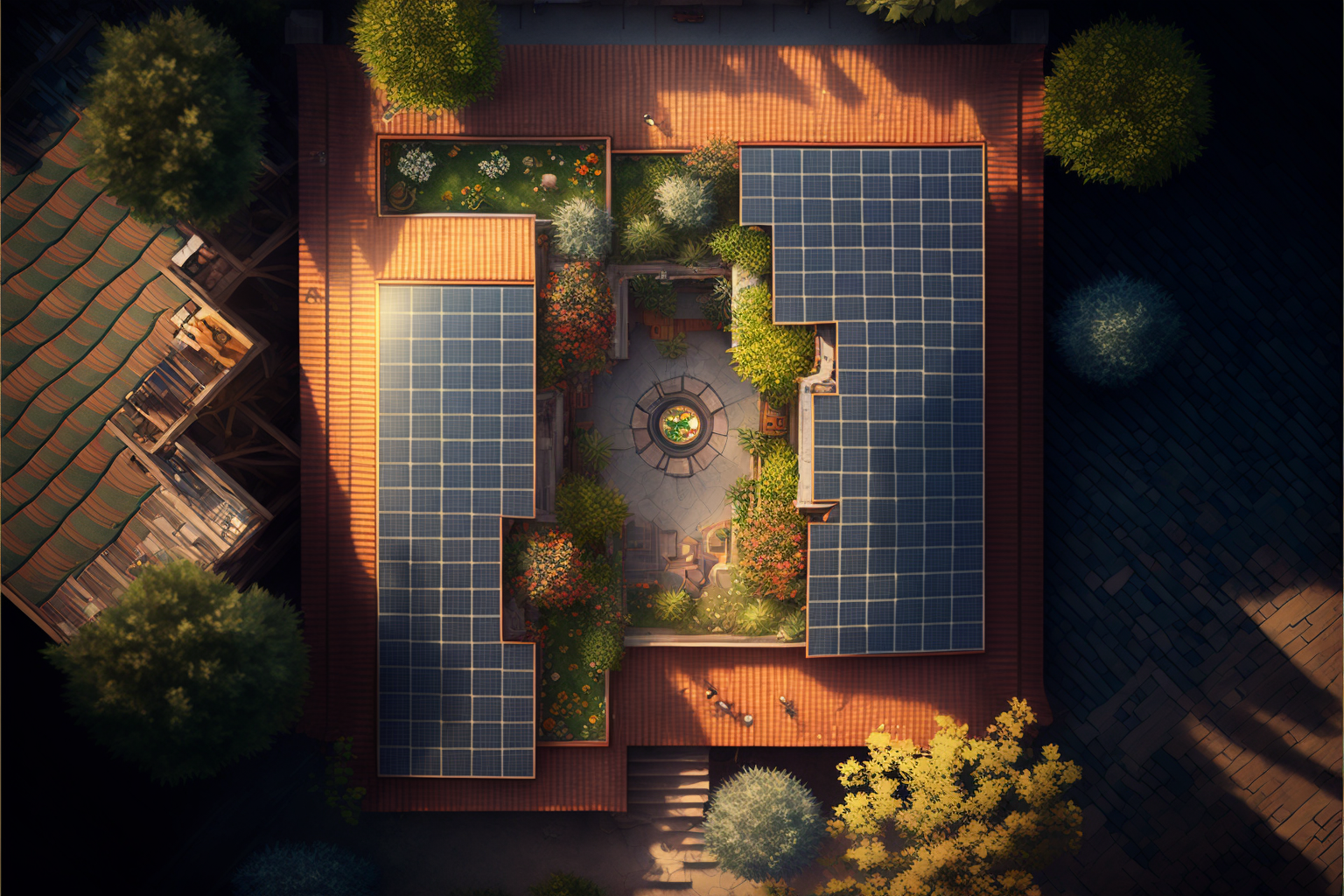PV generator design
If you know a lot about PV generator design, your solar power plant can provide electricity even when others have given up long ago.

PV modules are available from different manufacturers in different sizes (dimensions and power), even in different colors. Yes, there are also red PV modules.
In order to not go beyond the scope of this article, we will go into technical parameters in detail elsewhere, because they are of course relevant for fine tuning. However, here we will explain basic principles that are important for design considerations.
We don't want to start with Adam and Eve, i.e. you should know what current is and what voltage is. Also that power = current * voltage.
You should also know that PV modules deliver DC current and that - usually - most consumers in the household need AC current (and therefore you have to convert DC->AC).
Serial and parallel interconnection
When PV modules are connected serially (in series), the voltage of the whole ensemble increases and the current corresponds - ideally - to the current flow of a single PV module. In other words: the voltages add up, current remains the same.
When PV modules are connected in parallel, the current flow increases, but the voltage remains the same. In other words: the currents add up, the voltage remains the same.
Assuming you have 20 PV modules, there are many possibilities to connect them. On the one hand this means that there is no one best solution, on the other hand not every configuration makes sense at all.
You could connect all 20 modules in series - this is called a 20s1p configuration - here you would have the highest voltage and the lowest current flow (the power remains). You could also connect all 20 modules in parallel, which would be a very unusual 1s20p configuration with interesting features but electrical pitfalls.
Then there are many things in between: 4s5p, 5s4p, 10s2p, ... from which the basic operating parameters (voltage and current of the PV generator) are derived. Sometimes you are limited and would need 7s3p - that is 21 modules (the product of the numbers is always the number of modules). Then the question is whether you can get e.g. 21 modules on the surface, or you have to plan only with 6s3p (18 modules).
We keep in mind: the available possibilities of combining PV modules are large, but also necessary in view of individual requirements and limitations (space, electrical limits, etc.), as the following sections will show.
Strings, shading and other constraints
When modules are connected in series, it is called a "string" (string of modules). As mentioned above, the voltage which such a string delivers increases, but the current flow corresponds to that of a single module.
Strictly speaking, the current flow corresponds to the weakest current flow in the chain. And here is the crux: If only one of the modules in such a serial string is shaded, it "pulls down" the entire power of the string. One leaf on just one module, or the shadow of an antenna/chimney and several kilowatts of power can be prevented. This is why shading is such an important issue.
High voltages have advantages and disadvantages. Since low currents are sufficient to carry the power at high voltages, you also need smaller cross-sections of cables. Conversion from a high DC voltage to the required AC current can be done more efficiently (with fewer losses). However, you can't take the game as far as you want. Many modules have limits in their technical parameters. Some can only be operated in strings up to 1000V, others up to 1500V, but very rarely more.
More is often neither possible because of the inverter, nor desirable from a safety point of view. In case of a fire (the system doesn't have to burn, it's enough if the house underneath burns) the fire department is not exactly happy if there is 1000V voltage somewhere. After all, 1000V can find its way to the firefighter along such an extinguishing jet...
But there are also pitfalls with high currents. Most plugs and cables are designed for currents up to approx. 30A. This is often already reached with XX3p (3 parallel) configurations.
Alignment and inclination of PV modules 🧭
"South-facing roofs are best." Like most blanket statements, you can be sure that this is not so unqualifiedly true. Yes, in purely mathematical terms, there is an optimal orientation and slope at which you get the most yield. But is this the holy grail? Far from it! The sun moves across the sky during the course of the day and the year and thus ensures a high variability of yields. In order to be able to speak of a maximum yield at all, one must define "maximum" "in the annual average?", "in winter?", "in summer?".
In the past, a PV plant operator was simply interested in the maximum in the annual average. If the operator feeds in and gets a fixed remunerated price, then such a strategy makes sense. However, this strategy no longer makes sense as soon as the self-generated electricity has to be consumed locally. An orientation to the south will deliver the maximum yield around noon. But what if nobody is at home at noon to use the electricity? It is known that in households most of the electricity demand is in the morning and in the evening. In this case it would make more sense to orient the PV modules to the east and west.
In winter, the sun is low in the sky. For an optimal yield, the solar radiation should hit the PV module perpendicularly. Modules should therefore be placed at a steeper angle in winter and at a shallower angle in summer. This is the idea with tracked PV systems, which follow the path of the sun. These have been shown to have about 45% higher yield than fixed systems, but again have other problems:
- as mechanically active systems, a 25 year lifetime is difficult to achieve, certainly not without maintenance.
- these systems can - if at all - only be installed on flat roofs. Otherwise, they tend to be found only on open spaces.
- Due to their construction, such systems are more susceptible to storms and require measures to e.g. take the module surface "out of the wind" during storms.
Therefore, the rule of thumb for fixed systems is: module inclination = latitude. So if you live at 40° latitude, the ideal tilt for your PV modules would be 40°. That's already a very steep roof, but 35° is obviously better than 20° in that case.
Likewise, the rule of thumb says that higher slopes are better in winter (sun is low), lower slopes in summer. On the whole, yes, but in detail even this is too short-sighted.
Direct and diffused light
Not all light is the same. A PV system also generates electricity when it is cloudy and with significant yield under these conditions. Assuming you build a system with a very low inclination, it is very powerful in summer (because the sun is high). In winter, such a PV system is very low performance, because with direct sunlight, the light comes from a very shallow angle and this, of course, reduces the performance. In addition, very flat PV modules get dirty (because the rain can not wash off flat modules so well). Not to mention in winter, when the modules are snowed, the snow can't slide off these modules either.
BUT ☁️

Does this mean that flat modules are fundamentally unsuitable for winter? Certainly not. Because most of the time in winter there is cloudiness and diffuse light. In this situation, you have to imagine that (not snowy) flat modules are orthogonally (directly, at right angles) "looking" at the white clouds. These clouds are the brightest thing far and wide at that time. And so, paradoxically, a PV configuration that would otherwise seem to be a non-optimal solution for wintertime is nevertheless optimal in this not-so-rare situation. 💡
Capacity
We have talked in detail elsewhere about sizing a PV system and the result is often: fill up the roof!
Modules are cheap and the value of electricity is highly dependent on whether you have it or not. Nobody wants to pay too high a price per kWh all the time, but think about the cost of not having electricity. If you want a PV system that ensures your maximum independence, you must inevitably give preference to a design that prioritizes system output in winter.
And here's the thing: the area and diversification make the difference!
The optimal system does not know an "either-or", the optimal system knows an "and". Align PV modules to the east and west. Ideally, modules should be aligned vertically (facade and/or solar fence) to the south and your PV-supplied home is better prepared for the winter than the vast majority of systems you see today. ❄️

